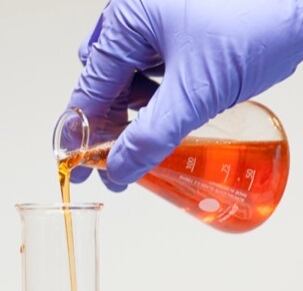Hofseth extracts its oil from the parts of salmon raised in Norwegian fish farms after that are left over after the filets are trimmed out. The company uses a gentle, enzyme-based process to liberate the oil, which makes it as close to eating the fish as it is possible to get in a supplement, the company says. The oil is a deep red color that results from its astaxanthin content.
Questions of farmed fish quality
One question that has swirled around the growth of the aquaculture industry in recent years is how do the products of that industry compare to wild caught counterparts? Specifically, if health authorities are recommending a certain number of servings of fatty fish per week to get adequate levels of omega-3s in the diet, will farmed fish, whose diet differs from their wild cousins, still supply that need? And what other kinds of chemicals, such as contaminants, might make their way into fish flesh via these new feed sources?
It’s an open question, and one that, according to Hofseth, has been answered definitively only for the Norwegian fish farming industry via an exhaustive review by Norwegian health authorities. Feeding practices within the industry have changed as the farms’ voracious demand for fish meal and fish oil has put pressure on fixed supplies of these ingredients from the ocean. Fish farmers have substituted feed from vegetable sources. According to the International Fishmeal and Fish Oil Organization (IFFO), the content of long-chain highly unsaturated omega-3 fats in raised salmon are being lowered due to pressure from limited supply of sustainable fish oil/meal, a finding with which the Norwegian review concurred.

The oil that Hofseth obtains (branded as OmeGo) by rendering the leftovers from salmon filet production has about 80 mg of EPA and DHA per gram of oil, which the company admits is far lower that the ultra-high concentrations that have become popular. But Matt Mixter, Hofseth’s managing director in the US, said the company has a different story to tell.
“Our standard is the freshness of the raw material and the way the oil is liberated from the flesh is much more important that the nominal level of omega-3s,” Mixter told NutraIngredients-USA.
Minimum, but sufficient
“Larger amounts of EPA and DHA can have benefits for numerous array of things. But we looked at how much EPA and DHA is just enough for keeping arteries clear and flexible,” said Tim Avila, a California-based business development specialist who has been consulting with Hofseth.
In a preclinical trial using a mouse model that was published in the The Journal of Functional Foods in Health and Disease, Avila said the company found that a human equivalent dose of 80 mg/day EPA and DHA is sufficient to deliver a significant reduction of ‘oxidized LDL’ as a surrogate for a healthy vascular system. Avila said the study also showed that dosage was superior to a more highly concentrated oil for that particular biomarker.
“We believe the freshness and oxidation of the oil matters to its bioactivity. We supply a product that has whatever was in the oil in its raw material state with nothing left behind. And it supplies a minimum but sufficient amount of EPA and DHA,” Mixter said.
Avila said the product also has a strong sustainability story to tell. With pressure on the worldwide supply of marine ingredients growing, Hofseth is recovering servings of EPA and DHA that would otherwise be diverted to other uses.
